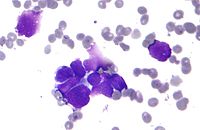
Photo from wikipedia
ATC is a very rare, but extremely aggressive form of thyroid malignancy, responsible for the highest mortality rate registered for thyroid cancer. In patients without known genetic aberrations, the current… Click to show full abstract
ATC is a very rare, but extremely aggressive form of thyroid malignancy, responsible for the highest mortality rate registered for thyroid cancer. In patients without known genetic aberrations, the current treatment is still represented by palliative surgery and systemic mono- or combined chemotherapy, which is often not fully effective for the appearance of drug resistance. Comprehension of the mechanisms involved in the development of the resistance is therefore an urgent issue to suggest novel therapeutic approaches for this very aggressive malignancy. In this study, we created a model of anaplastic thyroid cancer (ATC) cells resistant to paclitaxel and investigated the characteristics of these cells by analyzing the profile of gene expression and comparing it with that of paclitaxel-sensitive original ATC cell lines. In addition, we evaluated the effects of Dihydrotanshinone I (DHT) on the viability and invasiveness of paclitaxel-resistant cells. ATC paclitaxel-resistant cells highlighted an overexpression of ABCB1 and a hyper-activation of the NF-κB compared to sensitive cells. DHT treatment resulted in a reduction of viability and clonogenic ability of resistant cells. Moreover, DHT induces a decrement of NF-κB activity in SW1736-PTX and 8505C-PTX cells. In conclusion, to the best of our knowledge, the results of the present study are the first to demonstrate the antitumor effects of DHT on ATC cells resistant to Paclitaxel in vitro.
Journal Title: International Journal of Molecular Sciences
Year Published: 2021
Link to full text (if available)
Share on Social Media: Sign Up to like & get
recommendations!